|
|
|
Sort Order |
|
|
|
Items / Page
|
|
|
|
|
|
|
| Srl | Item |
| 1 |
ID:
147198
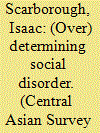

|
|
|
|
|
| Summary/Abstract |
This article analyses the rise of social unrest in the Tajik SSR in 1990–1991 from the perspective of the republic’s place within the broader Soviet economy and the collapse of that economy over the course of perestroika (1985–1991). Countering standard narratives of glasnost, democratization and nationalism in Tajikistan, it demonstrates that a close reading of the historical record points to sharp economic downturn as the most plausible immediate cause of the social disorder that came to engulf the Tajik SSR in the final years of the USSR and led to the Tajik Civil War of the 1990s.
|
|
|
|
|
|
|
|
|
|
|
|
|
|
|
|
| 2 |
ID:
134144
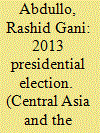

|
|
|
|
|
| Publication |
2014.
|
| Summary/Abstract |
The author looks at the problem of the legitimacy of the 2013 presidential election in Tajikistan as a sine qua non of social and political stability and, consequently, of the country's security and territorial integrity. In Tajikistan's specific case, the election could only be legitimate if the opposition forces, primarily the Islamic Revival Party of Tajikistan (IRP), which comes second after the institution of presidential power as the most influential political force, did not boycott it.
Despite the easily predicted results (another term for President Rakhmon), the IRP leaders decided to take part in the process: an Islamic revival could only take place in a politically stable Tajikistan. To gain public legitimacy for their decision, they organized a series of consultations with representatives of the public to formulate and realize the idea of an Alliance of the Reformist Forces of Tajikistan (ORST), which nominated human rights activist Oinihol Bobonazarova as its joint presidential candidate. She did not run because, after failing to present the necessary number of signatures gathered in her support to the Central Election Commission, she was not registered as a candidate. The IRP leaders abstained from voting, but denied all accusations of boycotting the election.
President Rakhmon, who won the election, and the IRP, which stuck resolutely to its course and was able to keep the Islamic revival going, were both winners. The country benefited the most-the election did not shake the frail stability, while Tajikistan's enemies lost another chance to interfere in its domestic affairs with destructive intentions.
|
|
|
|
|
|
|
|
|
|
|
|
|
|
|
|
| 3 |
ID:
181823
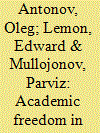

|
|
|
|
|
| Summary/Abstract |
While there have been a number of studies of the political economy of knowledge production in Central Asia, the often exploitative relations between foreign and local researcher, there has been less discussion of what Elizabeth Perry recently described as the ‘scholar–state’ nexus: how authoritarian rule rests on the suppression of independent academics, the ‘educated acquiescence’ of academia or their incorporation into the ‘factory of answers’. Through the concepts of suppression, acquiescence and incorporation, this article examines how restrictions on academic freedom have an impact on knowledge production in Tajikistan.
|
|
|
|
|
|
|
|
|
|
|
|
|
|
|
|
| 4 |
ID:
072832
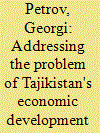

|
|
|
| 5 |
ID:
128387
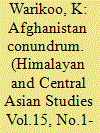

|
|
|
|
|
| Publication |
2011.
|
| Summary/Abstract |
Located at the crossroads of Central, South and West Asia and sharing. its borders with Central Asian Republics of Tajikistan, Uzbekistan and Turkmenistan on the north, Chinese province of Xinjiang in the east, [ran on the west and south west, and Pakistan and Pak-occu pied Kashmir on the south and south east, Afghanistan occupies a unique geo-strategic placement in the region. Distinct ethno-linguistic groups settled in different parts of .»'\fghanistan have diverse social moorings and political affiliations and aspirations. Th us the 'I'ajil
|
|
|
|
|
|
|
|
|
|
|
|
|
|
|
|
| 6 |
ID:
131852
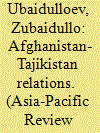

|
|
|
|
|
| Publication |
2014.
|
| Summary/Abstract |
This article attempts to touch upon the relations between Afghanistan and Tajikistan, two neighboring countries, from the historical perspective and the current period. The article analyses the history of Afghanistan-Tajikistan relations during and after the Soviet era, especially during the Afghan Mujahideen's struggle against the Soviet occupational army and Taliban regime in Afghanistan, the Tajikistan civil war of 1992-1997, and after September 11, 2001. In addition, the issues of the ethnic Tajiks in Afghanistan, the violent and vulnerable Tajik-Afghan border, the withdrawal of NATO troops from Afghanistan in 2014 and its impact on Afghanistan-Tajikistan relations, and the new phase of economic relations and an effective cooperation between the both countries are discussed. The article tries to fill the gaps within the body of existing literature and understanding concerning the topic.
|
|
|
|
|
|
|
|
|
|
|
|
|
|
|
|
| 7 |
ID:
097149
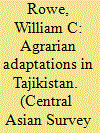

|
|
|
|
|
| Publication |
2010.
|
| Summary/Abstract |
In Central Asia, agriculture and water management have ranked as the two most important economic activities in this arid environment. These activities gained even more prominence during the Soviet era as planners expanded irrigation into previously marginal land that bolstered their vision that the best land be allocated exclusively for cotton production. In the wake of the fall of the Soviet Union, Tajikistan has enacted laws meant to expand and clarify land use categories to meet the dual targets of expanding food production within the country while maintaining as much land as possible in cotton production - their economic mainstay. To this end, the Tajik government instituted five categories of land tenure. Though comprehensive, these new dispositions merely mask a continuation of top-down agrarian decision making implemented during the Soviet period. Consequently, this change has created new problems for farm labourers as they struggle to adapt to post-Soviet life and negotiate with the new bureaucracy in the face of 'de-modernization' and the loss of jobs, wages, and in many cases, access to productive land. This research demonstrates that the means by which the Tajik government expanded food production has contributed to agricultural problems apparent at the time of independence.
|
|
|
|
|
|
|
|
|
|
|
|
|
|
|
|
| 8 |
ID:
103132
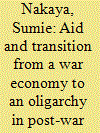

|
|
|
|
|
| Publication |
2009.
|
| Summary/Abstract |
Exclusion and violence persist in post-conflict states, despite international assistance aimed at the demilitarization of politics. Through a field-based study of Tajikistan, this paper argues that aid focuses on economic liberalization, not the implementation of peace agreements, in the initial stage of post-war transition. Such an organization of aid empowers a particular group of elites who have privileged access to state assets at the time of civil war settlement, allowing them to establish institutional frameworks that will consolidate their personal and monopolistic control of resources. This leads to the collapse of power-sharing arrangements, as the incumbent regime seeks to remove wartime commanders and opposition leaders from the administrative apparatus. In Tajikistan, the incumbent regime has also prosecuted many of these former allies and opponents on account of corruption through state agencies established with donor assistance. Aid thus institutionalized exclusion and sustains patterns of violence along civil war divisions, rather than transforming wartime power structures.
|
|
|
|
|
|
|
|
|
|
|
|
|
|
|
|
| 9 |
ID:
153010
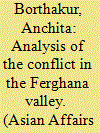

|
|
|
|
|
| Summary/Abstract |
The Ferghana valley which is an ethnically and culturally complex region divided among three Central Asian Republics of Kyrgyzstan, Tajikistan and Uzbekistan, witnessed a number of problems ranging from inter- ethnic tensions to border incursions; from security related complications to a number of socio- economic difficulties in the recent years. Moreover, it is also the most densely populated areas in Central Asia. Though sometimes the threat of religious extremism and intolerance in the Ferghana valley has been exaggerated yet it is difficult to completely deny their presence in the region and the obvious threat it has been posing for the entire Central Asia in future. The artificial delineation of border in the Ferghana valley which was finalized during the soviet era can be considered as one of the principle reasons behind the occurrences of various conflicts in the valley especially after the disintegration of the Soviet Union. Similarly, economy also plays a pivotal role in accentuating the conflict in the region as it is found that the root cause of majority of the conflicts prevalent in the region are regarding the domination of a particular ethnic group on the economic resources of that very area. However, the rivalry between the elites of the three republics and their struggle for power also play a prominent role in the disturbances that has been taking place in Ferghana valley as the elites of the valley do not want to lose their predominant position in the newly formed political establishments of their respective republics.
|
|
|
|
|
|
|
|
|
|
|
|
|
|
|
|
| 10 |
ID:
137386
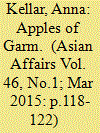

|
|
|
|
|
| Summary/Abstract |
This article surveys the challenges faced by agriculture in present-day Tajikistan. These include the collapse of supply chains, lack of access to markets and a shortage of labour following the collapse of the USSR – problems which Tajikistan has not been able to remedy unlike some other Central Asian states. This article looks at the effect of the problems, and the recent efforts to reform laws of land tenure in Tajikistan. It examines the effect of these reforms, particularly on families and women, and surveys the prospects that the latest reforms have for successful implementation.
|
|
|
|
|
|
|
|
|
|
|
|
|
|
|
|
| 11 |
ID:
127642
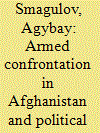

|
|
|
|
|
| Publication |
2013.
|
| Summary/Abstract |
The author looks at how the armed confrontation in Afghanistan affects the political and economic situation in Central Asia.
First, Afghanistan, which became a seat of international terrorism and religious extremism, as well as a foothold of the armed Tajik and Uzbek opposition in the 1990s, has developed into the real threat of a violent regime change in Tajikistan and Uzbekistan. In Tajikistan, the U.N. and certain other regional countries acting as intermediaries have successfully integrated the opposition into the country's peaceful development. The Uzbek opposition fighting on the side of the Taliban has been considerably weakened by the international counterterrorist coalition.
A compromise was reached in Tajikistan through constitutional amendments that legalized the Islamic party; on the other hand, we cannot rule out the possibility that in a country with a predominant Muslim population, Islam, a legal political factor, might come to power through democratic elections (this has already happened in Egypt).
The leaders of Uzbekistan chose a different road: instead of negotiations and compromises, they squeezed the armed opposition out of the country to Afghanistan. Operation Enduring Freedom practically reduced to naught the threats of extremist attacks very real in 1999 and 2000.
The coming pull-out of the international coalition troops from Afghanistan and inevitable bout of civil war that will ensue are causing concern in the Central Asian states: their far from simple social and economic context might raise a high wave of Islamic radicalism.
Second, instability in Afghanistan prevents diversification of foreign economic ties; it makes the construction of southward highways and railways, as well as power lines and gas pipelines, impossible. Afghanistan remains an insurmountable barrier on the trade route between the Central Asian countries and Kazakhstan, on the one hand, and the South Asian and Middle Eastern countries, on the other, and (which is even more important) blocks access to their sea ports.
The counterterrorist operation that began in 2001 failed: the United States is pulling out of the country leaving behind the same "Afghan threat," which is causing the Central Asian states to look to Russia and China as possible guarantors of their security.
|
|
|
|
|
|
|
|
|
|
|
|
|
|
|
|
| 12 |
ID:
144160
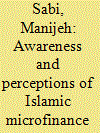

|
|
|
|
|
| Summary/Abstract |
This study examines the level of awareness and sources of demand for Islamic microfinance among the clients of microfinance institutions in Kyrgyzstan and Tajikistan. The research question is whether the source of demand is based on religious beliefs or the assumption of interest-free Islamic-compliant products. The field research uses a sample of 150 clients of several conventional microfinance institutions in these two countries. Although many analysts still maintain that there is a demand for Islamic microfinance in many parts of the world, the current qualitative and quantitative research indicates no clear demand for these products in these two countries. The relevant question for future research is whether microfinance users will demand Islamic microfinance instruments.
|
|
|
|
|
|
|
|
|
|
|
|
|
|
|
|
| 13 |
ID:
138248
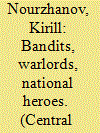

|
|
|
|
|
| Summary/Abstract |
The history of the Basmachi movement has occupied a prominent place in the construction of a collective past in Soviet and post-Soviet Tajikistan. This article traces the evolution of its representations in the dominant narrative from the 1950s to the present day. It argues that official discourse in contemporary Tajikistan situates the Basmachis in the mould of a national struggle against Turkic oppression, rather than portraying them, in the manner of earlier prevalent models, as part of a class-based or anti-colonialist resistance. Among many public counter-narratives, the one focusing on the local appeal of the Basmachi leaders has the greatest potential to challenge the government-sponsored reading of Tajikistan’s past and thus the image of a unified nation it seeks to support.
|
|
|
|
|
|
|
|
|
|
|
|
|
|
|
|
| 14 |
ID:
180305
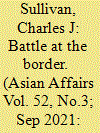

|
|
|
|
|
| Summary/Abstract |
The deadly skirmishes along the disputed border of Kyrgyzstan and Tajikistan in late April 2021 stand out in comparison to other recent clashes between residents of this remote area. This article analyzes the 2021 border conflict. Furthermore, it stands to reason that the current political climate serves to hinder any resolution to this interstate dispute. Lastly, since skirmishes between Kyrgyzstan and Tajikistan (both members of the Collective Security Treaty Organization) serve as a source of potential embarrassment for the Russian Federation, Moscow will seek to assert its leverage, in the hopes of avoiding future clashes and maintaining its hegemony over Central Asia.
|
|
|
|
|
|
|
|
|
|
|
|
|
|
|
|
| 15 |
ID:
153710


|
|
|
|
|
| Summary/Abstract |
Soon after the breakdown of the Soviet Union in 1991, a civil war started in Tajikistan (1992–97). This was also the period when a number of international organizations arrived in the country to distribute humanitarian assistance and assist in conflict resolution and stabilization. After the UN, the Organization for Security and Co-operation in Europe (OSCE) was the second key organization which appeared in the conflict-stricken country. Like other key international organizations in Tajikistan, the OSCE, which has been in the country since 1994, has seen a shift in its original functions of monitoring and emergency assistance. Some see its avowed objectives in the new century as formalistic, virtual and ineffective. By capturing perceptions of foreign assistance to Tajikistan among employees of the OSCE and other international organizations, NGO workers, government officials and ordinary citizens, this article explores how Tajikistan ‘socialized’ the OSCE, making the organization simultaneously a benefactor, an industry and even an intruder.
|
|
|
|
|
|
|
|
|
|
|
|
|
|
|
|
| 16 |
ID:
091842
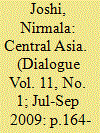

|
|
|
|
|
| Publication |
2009.
|
| Summary/Abstract |
The geopolitical salience of Central Asia for India was never in doubt;either in the past or in the present. Two momentous developments of the last decade have brought this salience in an even more sharper and pointed manner than before.
|
|
|
|
|
|
|
|
|
|
|
|
|
|
|
|
| 17 |
ID:
125449
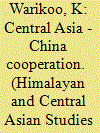

|
|
|
|
|
| Publication |
2013.
|
| Summary/Abstract |
China considers herself to be an important player in the new geopolitics of Central Asia not only because it shares nearly 3000 Kms. of it strategic frontiers in Xingjian with the Central Asian states of Kazakhstan, Kyrgyzstan and Tajikistan, but also due to cross border fraternization of Muslim population inhabiting this area, which makes borders vulnerable to ethnic religious separatism.
|
|
|
|
|
|
|
|
|
|
|
|
|
|
|
|
| 18 |
ID:
106157
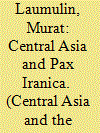

|
|
|
| 19 |
ID:
118776
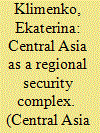

|
|
|
| 20 |
ID:
115609
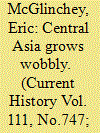

|
|
|
|
|
| Publication |
2012.
|
| Summary/Abstract |
Aging autocrats and an absence of clear succession mechanisms make a combination that, if not soon addressed, will lead to political upheaval. .
|
|
|
|
|
|
|
|
|
|
|
|
|
|
|
|
|
|
|
|
|